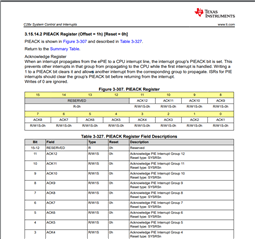Other Parts Discussed in Thread: C2000WARE
This is a modification of the original post. I tried to lead my original post with a clearer summary and statement of my problem:
I tried to modify a TI-provided example for basic IPC communication so it is bi-directional, but I am having a problem.
The TI example is this:
"C:\ti\c2000\C2000Ware_4_03_00_00\driverlib\f2838x\examples\c28x_cm\ipc\CCS\ipc_ex1_basic.projectspec"
It has two source files: "ipc_ex1_basic_c28x1.c" and "ipc_ex1_basic_cm.c".
This example code demonstrates the C28x processor using basic IPC API functions to send an array of 10 integers to the Communications Manager (CM) processor. I am able to build and run the example on the TI board as it is written.
I modified the example so that CM will use basic IPC functions to send an array of 10 integers back to the C28x after it receives the data from the C28x. In each program, I added a global variable which I increment within the IPC interrupt handler of the respective program.
Finally, I modified the example programs to continue to exchange messages in this way, one at a time, forever.
The problem is that the IPC interrupt handler function is not invoked a second time after the first time CM sends C28x an IPC message. Therefore, when the CM attempts to send a second message, it is endlessly waiting for an acknowledgement from the C28x side. Just as in the unmodified example, I am calling IPC_sendResponse() and IPC_ackFlagRtoL() after first calling IPC_readCommand() within the IPC ISR. Shouldn't the call to IPC_ackFlagRtoL() clear everything necessary so that the IPC flag can be used by the CM a second time to interrupt the C28x? I have attached the CM and C28x example projects (having my modifications).
The following is the original post with a little more detail ...
I modified the "ipc_ex1_basic_cm" example in two ways:
1. I added code to have a message with data sent back to CPU1 from the CM.
2. I modified the example so the CPU1 and CM would take turns sending each other messages using IPC.
I have been able to observe the following, and then a problem occurs:
a. CPU1 sends a message with data to CM using IPC with FLAG0
b. CM's handler uses IPC_readCommand(), IPC_sendResponse(), and IPC_ackFlagRtoL() with IPC_FLAG0. The handler increments a counter (which was initialized to 0 when the program started).
c. CPU1 waits for that ack and calls IPC_getResponse() to read the response value.
Steps a - c are repeated, this time with CM sending a message to CPU1 and CM is using IPC_FLAG1 to signal CPU1. The handler in CPU1 increments a counter (which was initialized to 0 when the program started).
The counter in each processor is now 1.
Steps a - c are repeated (CPU1 sending to CM). The counter on the CM side is now 2, while the counter on the CPU1 side is still 1.
Here is the problem:
Steps a - c are about to repeat (with CM sending to CPU1), but during step a, the CM remains blocked on the call to IPC_waitForAck(). The CPU1 code did not execute its handler for this second transmission by CM, so it does not call the IPC_ackFlagRtoL() function (which is part of the handler code).
The question is this - why is CPU1's handler not being invoked after it is invoked the first time? It seems as though something is not being cleared for CPU1 after its handler (for IPC_FLAG1) is invoked that first time, but I cannot figure it out.
No message queues are used (this is a modification of the basic IPC example).TI_help_ticket_IPC_lockup.zip



